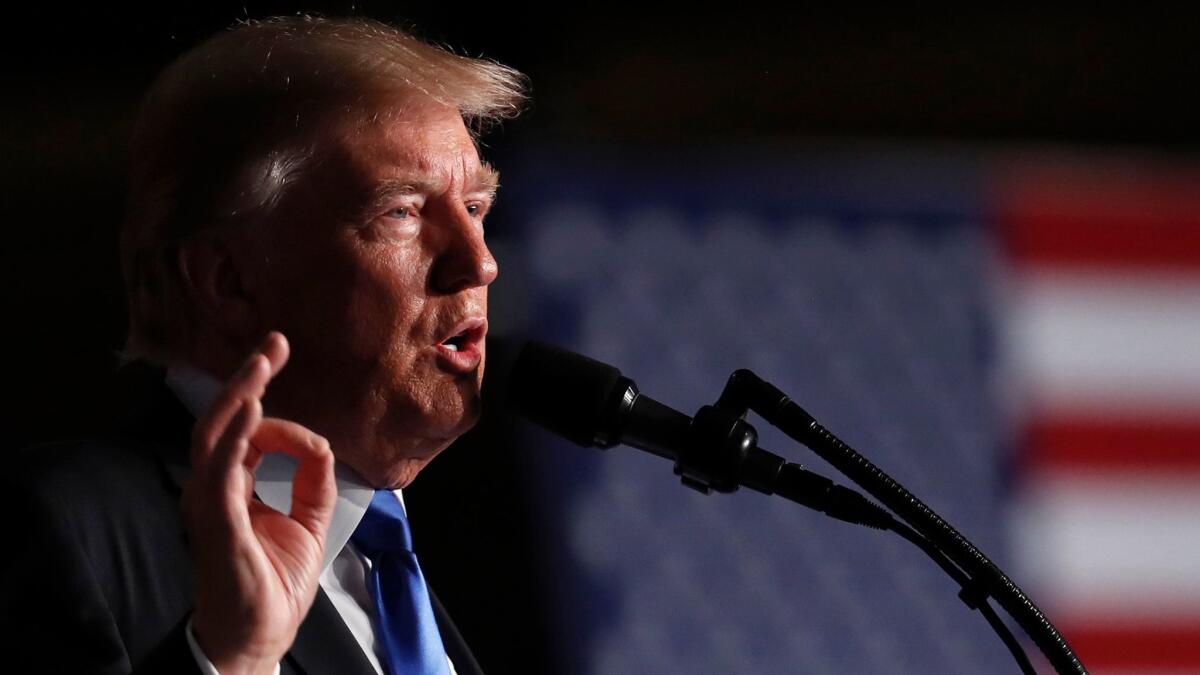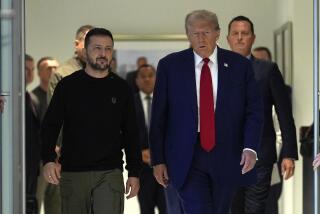Rather than swift military victory, Trump’s Afghanistan plan seeks stalemate and negotiated settlement

Reporting from WASHINGTON — As a presidential candidate, Donald Trump promised to wage war with overwhelming firepower and to achieve victory with lightning speed. His strategy for Afghanistan offers neither.
In his speech to the nation Monday, Trump instead offered protracted fighting against resurgent Islamist insurgents who have gained ground over the last year, and a promise that the 16-year war might end “some day” in a negotiated settlement — if the U.S.-led military effort is successful.
Rather than a clear-cut military victory, the goal of the Trump strategy is to convince Taliban fighters and other militants that U.S. forces are not leaving and they cannot depose the Kabul government on the battlefield, Secretary of State Rex Tillerson told reporters Tuesday.
“This entire effort is intended to put pressure on the Taliban, to have the Taliban understand you will not win a battlefield victory,” Tillerson said. “We may not win one, but neither will you. So at some point, we have to come to the negotiating table and find a way to bring this to an end.”
Trump’s plan may have the advantage of being vague enough to at least temporarily avoid alienating some supporters who were attracted by his militaristic vows on the campaign trail, and to win over hawkish Republicans in Congress.
But it extends and again deepens U.S. involvement in a long and unpopular war that already has taken nearly 2,400 American lives and cost more than $700 billion in U.S. support — a direction that Trump acknowledged Monday went against his own instincts.
The shift in Trump’s thinking signals the influence not only of Pentagon commanders, led by retired Marine general and now Defense Secretary James N. Mattis, but also of the top advisors Trump brought into the White House — in particular Army Gen. H.R. McMaster as national security advisor and retired Marine Gen. John F. Kelly as chief of staff.
Mattis said Tuesday on a visit to Baghdad that the new strategy for Afghanistan will try to replicate “a lot” of the military tactics that have successfully pushed Islamic State fighters from large parts of Iraq and Syria since 2014.
Key to those offensives has been a willingness to place U.S. advisors nearer to the front lines, including for close-in drone and helicopter support, to help ground assaults by local forces. The Americans help on battlefield strategy, fire artillery and coordinate airstrikes on enemy targets.
U.S. warplanes already have stepped up the Afghan war, dropping more than twice as many bombs and missiles so far this year compared with this time a year ago — 1,984 munitions through July 31, up from 705 last year, according to Air Force statistics.
But Mattis said he is still awaiting a detailed plan from Gen. Joseph F. Dunford Jr., chairman of the Joint Chiefs of Staff, for how to implement the endgame strategy that Trump outlined Monday.
Trump didn’t announce a new troop increase, but he has given Mattis authority to send about 4,000 more, adding to 8,400 U.S. forces now deployed there. Mattis said he won’t decide a precise figure until he gets Dunford’s plan.
“When he brings that to me, I will determine how many more we need to send in,” Mattis said. “It may or may not be the number that is bandied about.”
Their immediate mission will be to step up training and advising Afghan security forces, which suffered severe casualties as U.S. forces dropped from more than 100,000 in President Obama’s first term to the current levels.
After Obama declared an end to U.S. combat in the country in December 2014 and withdrew most U.S. forces, the Taliban regained control of large parts of northern and southern Afghanistan.
They now control 40% of the country’s 407 districts, according to the most recent assessment by the special inspector general for Afghanistan reconstruction.
Though some U.S. troops may head for Afghanistan within days, it will take “some time” to expand the U.S.-led training and advising of Afghan forces, Tillerson said.
“We believe that we can turn the tide of what has been a losing battle over the last year and a half or so and at least stabilize the situation and hopefully start seeing some battlefield victories,” Tillerson said.
Pentagon commanders long have argued that a negotiated settlement was the only likely outcome of the Afghan war. They cited the weakness of Afghan security forces, rampant corruption in the Kabul government and the ability of insurgents to operate from neighboring Pakistan.
Trump’s approach is not that different from those tried by Presidents Obama and George W. Bush, who both sought to draw the Taliban into peace talks by pressuring it on the battlefield.
Like Trump, both also sought to pressure Pakistan into shutting down sanctuaries used by insurgents near the border.
In frustration at Pakistani inaction, Obama approved hundreds of CIA drones strikes against militant leaders and training camps in the country’s rugged northwestern tribal areas.
Although Trump castigated Pakistan in his speech, it’s unclear whether he will resume the drone strikes, which largely ended by 2016 amid widespread public protests in Pakistan.
But Obama also set tight limits on U.S. troop levels in Afghanistan and firm deadlines for withdrawing them, a source of Pentagon frustration. He also provided billions of dollars for reconstruction and democratization programs.
Trump, in contrast, said he would not provide a “blank check” for U.S. support to the Afghan government, would not support nation-building efforts and would not be hemmed in by deadlines.
Mattis declined to provide specifics on the new strategy or say precisely how Pakistan and India figure in.
“There is a broader approach to this and it all comes down to the execution and we will have to stand and deliver on this,” Mattis said. “You’ll just have to watch it unfold to really get the answer to it.”
Derek Chollet, a former senior Pentagon official in the Obama administration, said the Trump strategy will take years to show results, testing the president’s notoriously short attention span, especially if the United States and its allies suffer battlefield setbacks.
“The underpinnings of this strategy go against every one of [Trump’s] instincts,” said Chollet, vice president of the German Marshall Fund, a Washington foreign policy organization. “Once the prevailing winds go the other way, is he going to say, ‘I got railroaded by the damn generals’?”
Democrats faulted Trump for deepening U.S. engagement in the long-running conflict without providing a detailed plan.
Rep. Adam Smith of Washington state, the top Democrat on the Armed Services Committee, called the Trump plan “an open-ended war effort.” Trump, he added, “now owns the responsibility for this war and any consequences that flow from this decision-making process.”
ALSO
U.S.-backed Iraqi forces keep up grinding battle against Islamic State
Pentagon chief says new strategy for Afghanistan will replicate tactics used against Islamic State
Trump, who once backed withdrawal from Afghanistan, tries to sell the nation on deeper involvement
More to Read
Get the L.A. Times Politics newsletter
Deeply reported insights into legislation, politics and policy from Sacramento, Washington and beyond. In your inbox three times per week.
You may occasionally receive promotional content from the Los Angeles Times.













